Related Research Articles
Swathi Thirunal Rama Varma was the Maharaja of the Kingdom of Travancore. He is also considered as a brilliant music composer and is credited with over 400 classical compositions in both Carnatic and Hindustani style.
Iravivarman Thampi, better known as Irayimman Thampi, was an Indian Carnatic musician, music composer and poet from the Kingdom of Travancore. He was a vocalist in the court of Swathi Thirunal. His compositions include the lullaby Omanathinkal Kidavo, one of the most popular lullabies in Malayalam.

The Thampis and Kochammas are the sons and daughters of the maharajahs of Travancore and their consorts belonging to Samanthan Nair caste

Rama Varma I often referred to as Dharma Raja, was the Maharajah of Travancore from 1758 until his death in 1798. He succeeded his uncle Marthanda Varma, who is credited with the title of "maker of modern Travancore". During his reign Dharma Raja not only retained all the territories his predecessor had gained but administered the kingdom with success. He was addressed as Dharma Raja on account of his strict adherence to Dharma Sastra, the Hindu principles of justice by providing asylum to thousands of Hindus and Christians fleeing Malabar during the Mysorean conquest of Malabar.

Ayilyam Thirunal Rama Varma (1832–1880) was the ruler of the princely state of Travancore in India from 1860 to 1880. His reign was highly successful, with Travancore gaining the appellation of "model state of India". Ayilyam Thirunal was the nephew of Uthram Thirunal and Swathi Thirunal and grandson of Gowri Lakshmi Bayi.
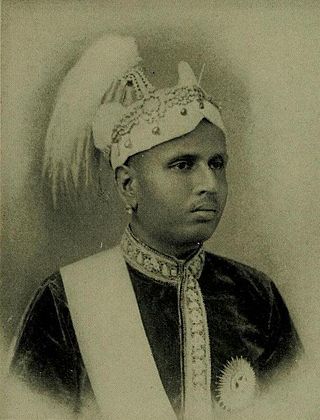
Sir Moolam Thirunal Rama Varma (1857–1924) was Maharajah of the princely state of Travancore between 1885 and 1924, succeeding his uncle Maharajah Visakham Thirunal (1880–1885). Moolam Thirunal is considered as the first in Indian to implement the concept of public participation in governance through the formation of Travancore Legislative Council.
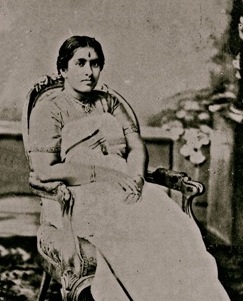
Pooradam Thirunal Sethu Lakshmi Bayi CI was the monarch, though designated as the Regent due to British policy, of the Kingdom of Travancore in southern India between 1924 and 1931. She, along with her younger cousin, Moolam Thirunal Sethu Parvathi Bayi, were adopted into the Travancore royal family and were the granddaughters of the celebrated painter, Raja Ravi Varma.
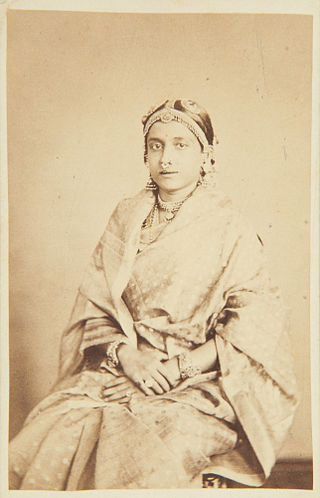
Ammachi Panapillai Amma was the title held by the consort of the ruling Maharajah of Travancore as well as those of other title-holding male members of the Travancore Royal Family.

Maharani Ayilyom Thirunal Gouri Lakshmi Bayi (1791–1815) was the Maharani of the Indian state of Travancore from 1810 till 1813 and Regent from 1813 till her death in 1815 for her son Swathi Thirunal Rama Varma. She was the only Queen of Travancore to have reigned in her own right which she did for two years before becoming a regent.

Uthrittathi Thirunal Gowri Parvathi Bayi (1802–1853) was the Regent of the Indian state of Travancore in 1815–1829. She succeeded her sister Maharani Gowri Lakshmi Bayi, till her regency was relinquished in favour of her nephew, Maharajah Swathi Thirunal.

Visakham Thirunal Rama VarmaFRAS was the Maharaja of the erstwhile Indian kingdom of Travancore from 1880 to 1885 AD. He succeeded his elder brother Maharajah Ayilyam Thirunal to the throne of Travancore.

Uthram Thirunal Marthanda Varma was the Maharajah of Travancore state in southern India, succeeding his elder brother Maharajah Swathi Thirunal in 1846 till his demise in 1860. Known for his progressive rule, he abolished slavery in the kingdom. He was succeeded by his nephew Maharajah Ayilyam Thirunal in 1860. His mother was Her Highness Maharani Gowri Lakshmi Bayi. He was married to Thiruvattar Ammachi Panapillai Amma Srimathi Madhavi Pillai Kochamma of the Nagercoil Ammaveedu, who died in 1860, a few months before the Maharajah's death. The Maharajah's daughter was married by his nephew and heir Maharajah Ayilyam Thirunal.
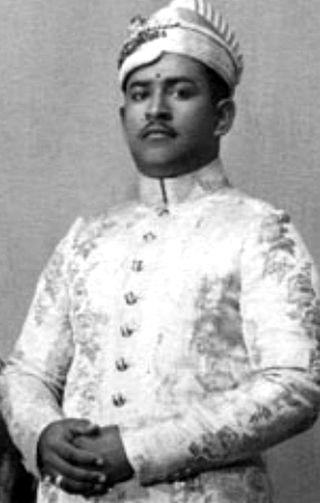
Sree Padmanabhadasa Sree Uthradom Thirunal Marthanda Varma was the titular Maharaja of Travancore. He was the younger brother of the last ruling monarch of the Kingdom of Travancore, Maharajah Chithira Thirunal Balarama Varma.

The Travancore royal family was the ruling house of the Kingdom of Travancore. They had to give up their ruling rights in 1949 when Travancore merged with India and their political pension privileges were abolished in 1971. The family is descended from the Ay/Venad family and the Chera dynasty.
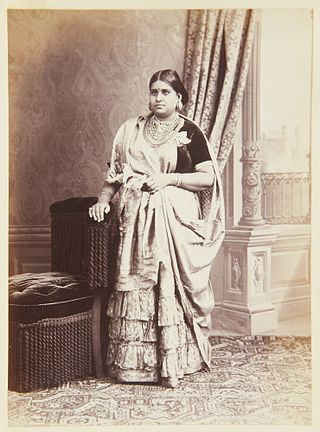
Maharani Bharani Thirunal Lakshmi Bayi CI was the Senior Rani of Travancore from 1857 till her death in 1901. Her consort was the famous poet and writer, styled the father of Malayalam literature, Sri Kerala Varma Valiya Koil Thampuran.

Rani Bharani Thirunal Parvathi Bayi was a junior Rani of Travancore as known as ' Attingal Elaya Rani ' Her consort was Kilimanoor Kerala Varma Koyi Thampuran. Parvathi Bayi was born in 1850 as the daughter of Bharani Thirunal Amma Thampuran of Utsava Madom Palace in Mavelikara.

Sree Padmanabhadasa Sree Moolam Thirunal Rama Varma is the current incumbent to the throne of Travancore. He is the youngest of the four children of the former titular Maharani of Travancore, Sree Padmanabhasevini Maharani Karthika Thirunal Lakshmi Bayi and her husband, Prince Consort Lt. Col. G. V. Raja of Poonjar Royal House.
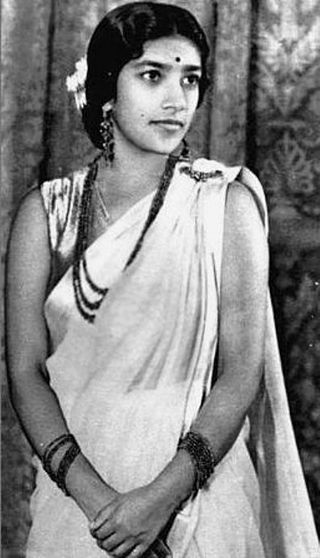
Maharani Karthika Thirunal Lakshmi Bayi (1916-2008) was the only sister of the last ruling Maharajah of Travancore, Sree Chithira Thirunal Balarama Varma and of his successor, Sree Uthradom Thirunal Marthanda Varma. Under the matrilineal Marumakkathayam system of inheritance prevalent in the kingdom of Travancore, it was her children who were heirs to the throne. She therefore held a very special place in the Travancore court, superior to the Maharaja's wives, and was termed the Rani of Attingal in her own right. In 2013, her only surviving son duly succeeded his uncles as titular Maharaja of Travancore and is known as Moolam Thirunal Rama Varma.

Moolam Thirunal Sethu Parvathi Bayi (1896–1983), better known as Amma Maharani, was the Junior Maharani (Queen) of Travancore as well as a promoter of Indian Classical music. She was the mother of Chithira Thirunal Balarama Varma, the last King of Travancore. She was the president of the National Council of Women in India in 1938–1944.
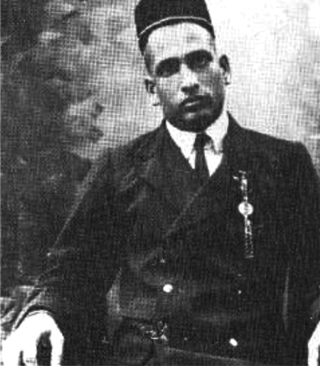
Koyi Thampuran was the title of the Prince Consorts of the Queens and Princesses of Travancore. The Koyi Thampurans' gained prominence and prestige in Kingdom of Travancore as they were the fathers of the then reigning Kings. In Travancore, there were ten clans of Koyi Thampurans. The most ancient were the ones settled at Kilimanoor ; others were Kirthipuram, Pallam, Paliyakkara and Nirazhi, Ananthapuram, Chemprol, Cherukol, Karazhma and Vatakkemadham.
References
- ↑ Nagam Aiya Travancore Manual Vol II page 335
- ↑ Native life in Travancore By Samuel Mateer Published in 1883, W. H. Allen & Co. (London)
- ↑ Velu Pillai Travancore Manual Volume II page 709
- ↑ Thiruvananthapurathinthe Ehithihasam
- ↑ The life and times of Maharani Setu Lakshmi Bayi by Lakshmi Raghunandan